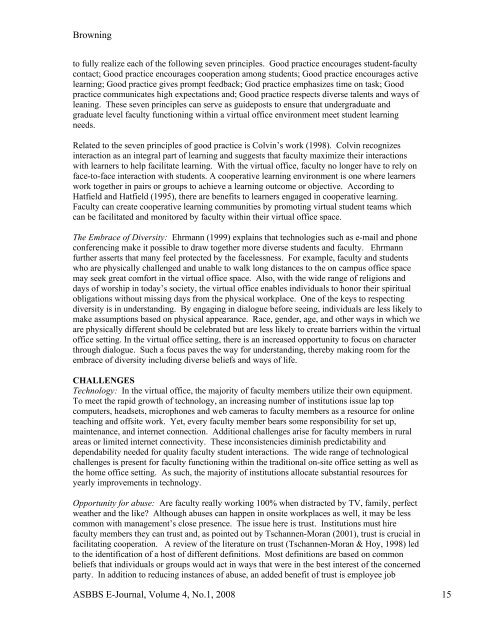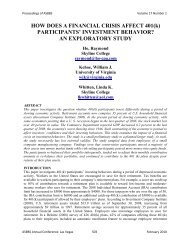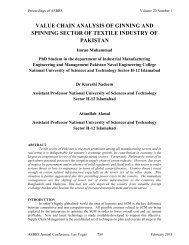stock repurchase announcements: a test of market ... - Asbbs.org
stock repurchase announcements: a test of market ... - Asbbs.org
stock repurchase announcements: a test of market ... - Asbbs.org
You also want an ePaper? Increase the reach of your titles
YUMPU automatically turns print PDFs into web optimized ePapers that Google loves.
Browning<br />
to fully realize each <strong>of</strong> the following seven principles. Good practice encourages student-faculty<br />
contact; Good practice encourages cooperation among students; Good practice encourages active<br />
learning; Good practice gives prompt feedback; God practice emphasizes time on task; Good<br />
practice communicates high expectations and; Good practice respects diverse talents and ways <strong>of</strong><br />
leaning. These seven principles can serve as guideposts to ensure that undergraduate and<br />
graduate level faculty functioning within a virtual <strong>of</strong>fice environment meet student learning<br />
needs.<br />
Related to the seven principles <strong>of</strong> good practice is Colvin’s work (1998). Colvin recognizes<br />
interaction as an integral part <strong>of</strong> learning and suggests that faculty maximize their interactions<br />
with learners to help facilitate learning. With the virtual <strong>of</strong>fice, faculty no longer have to rely on<br />
face-to-face interaction with students. A cooperative learning environment is one where learners<br />
work together in pairs or groups to achieve a learning outcome or objective. According to<br />
Hatfield and Hatfield (1995), there are benefits to learners engaged in cooperative learning.<br />
Faculty can create cooperative learning communities by promoting virtual student teams which<br />
can be facilitated and monitored by faculty within their virtual <strong>of</strong>fice space.<br />
The Embrace <strong>of</strong> Diversity: Ehrmann (1999) explains that technologies such as e-mail and phone<br />
conferencing make it possible to draw together more diverse students and faculty. Ehrmann<br />
further asserts that many feel protected by the facelessness. For example, faculty and students<br />
who are physically challenged and unable to walk long distances to the on campus <strong>of</strong>fice space<br />
may seek great comfort in the virtual <strong>of</strong>fice space. Also, with the wide range <strong>of</strong> religions and<br />
days <strong>of</strong> worship in today’s society, the virtual <strong>of</strong>fice enables individuals to honor their spiritual<br />
obligations without missing days from the physical workplace. One <strong>of</strong> the keys to respecting<br />
diversity is in understanding. By engaging in dialogue before seeing, individuals are less likely to<br />
make assumptions based on physical appearance. Race, gender, age, and other ways in which we<br />
are physically different should be celebrated but are less likely to create barriers within the virtual<br />
<strong>of</strong>fice setting. In the virtual <strong>of</strong>fice setting, there is an increased opportunity to focus on character<br />
through dialogue. Such a focus paves the way for understanding, thereby making room for the<br />
embrace <strong>of</strong> diversity including diverse beliefs and ways <strong>of</strong> life.<br />
CHALLENGES<br />
Technology: In the virtual <strong>of</strong>fice, the majority <strong>of</strong> faculty members utilize their own equipment.<br />
To meet the rapid growth <strong>of</strong> technology, an increasing number <strong>of</strong> institutions issue lap top<br />
computers, headsets, microphones and web cameras to faculty members as a resource for online<br />
teaching and <strong>of</strong>fsite work. Yet, every faculty member bears some responsibility for set up,<br />
maintenance, and internet connection. Additional challenges arise for faculty members in rural<br />
areas or limited internet connectivity. These inconsistencies diminish predictability and<br />
dependability needed for quality faculty student interactions. The wide range <strong>of</strong> technological<br />
challenges is present for faculty functioning within the traditional on-site <strong>of</strong>fice setting as well as<br />
the home <strong>of</strong>fice setting. As such, the majority <strong>of</strong> institutions allocate substantial resources for<br />
yearly improvements in technology.<br />
Opportunity for abuse: Are faculty really working 100% when distracted by TV, family, perfect<br />
weather and the like? Although abuses can happen in onsite workplaces as well, it may be less<br />
common with management’s close presence. The issue here is trust. Institutions must hire<br />
faculty members they can trust and, as pointed out by Tschannen-Moran (2001), trust is crucial in<br />
facilitating cooperation. A review <strong>of</strong> the literature on trust (Tschannen-Moran & Hoy, 1998) led<br />
to the identification <strong>of</strong> a host <strong>of</strong> different definitions. Most definitions are based on common<br />
beliefs that individuals or groups would act in ways that were in the best interest <strong>of</strong> the concerned<br />
party. In addition to reducing instances <strong>of</strong> abuse, an added benefit <strong>of</strong> trust is employee job<br />
ASBBS E-Journal, Volume 4, No.1, 2008 15

















